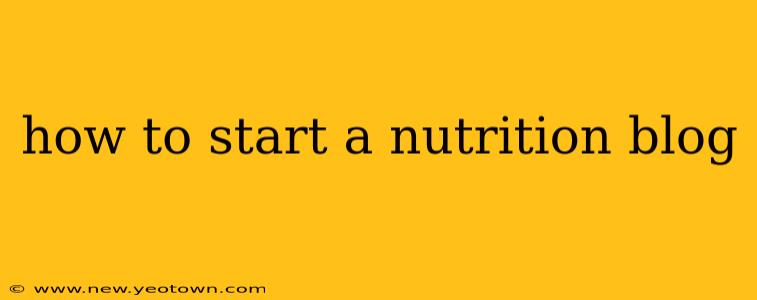How to Start a Nutrition Blog That Thrives: A Step-by-Step Guide
The world of nutrition is buzzing, and if you’re passionate about healthy eating and sharing your knowledge, starting a nutrition blog can be incredibly rewarding. But it’s not just about passion; it takes planning, strategy, and consistent effort to build a successful blog that attracts readers and establishes your authority. This isn't a get-rich-quick scheme; it's a journey of building a community around your expertise. Let's embark on that journey together.
My name is Alex, and I've been running successful health and wellness blogs for over five years. I've learned a thing or two along the way, and I’m excited to share my insights with you. This isn't just a theoretical guide; it's drawn from real-world experience.
1. Finding Your Niche: What Makes Your Blog Unique?
Before diving into website creation, you need a clear focus. The nutrition world is vast. Do you specialize in weight loss, plant-based diets, sports nutrition, children's nutrition, or something else entirely? Perhaps you want to focus on a specific dietary approach like keto, paleo, or Mediterranean. A well-defined niche helps you target your audience effectively and differentiate yourself from the competition. Thinking about what unique perspective or expertise you bring to the table is key. Are you a certified nutritionist, a passionate home cook, or someone who’s overcome personal health challenges through nutrition? Your unique story will resonate with readers.
2. Choosing a Name and Platform: Building Your Online Home
Your blog name should be memorable, relevant to your niche, and ideally, have a corresponding domain name available. Think carefully—this is the foundation of your brand. Once you have your name, it's time to choose a platform. WordPress.org (self-hosted) offers maximum flexibility and customization, while platforms like Wix or Squarespace provide simpler, user-friendly interfaces. Consider your technical skills when making this decision.
3. Designing Your Blog: First Impressions Matter
Your blog's design should be visually appealing, easy to navigate, and reflect your brand. Think about color schemes, fonts, and overall layout. Ensure your blog is mobile-friendly—many readers access content from their smartphones. Invest time in creating a professional-looking blog; it sets the tone for your entire content strategy.
4. Content Creation: The Heart of Your Blog
This is where the magic happens. High-quality, informative content is the key to attracting and retaining readers. Consider the following:
- Blog Post Ideas: Start with topics you’re passionate about and knowledgeable in. Think about common nutrition questions your target audience might have. Offer practical advice, recipes, meal plans, and insightful articles.
- Keyword Research: Learn how to use SEO tools to identify relevant keywords related to your niche. Incorporate these keywords naturally into your blog posts to improve search engine rankings.
- Content Calendar: Planning ahead ensures consistent publishing. A calendar helps you stay organized and maintain a steady flow of new content.
5. Promoting Your Blog: Getting the Word Out
Creating great content is only half the battle. You need to actively promote your blog to reach your target audience. Here's how:
- Social Media Marketing: Utilize platforms like Instagram, Facebook, and Pinterest to share your blog posts, engage with your audience, and build a community.
- Email Marketing: Building an email list allows you to directly connect with your readers and notify them of new posts.
- Guest Blogging: Contribute articles to other relevant blogs in your niche to expand your reach and gain exposure.
6. Monetization Strategies: Turning Your Passion into Profit
While building a community is paramount, monetization is important for long-term sustainability. Here are a few options:
- Affiliate Marketing: Recommend products or services relevant to your niche and earn a commission on sales.
- Sponsored Posts: Partner with brands to create sponsored content that aligns with your blog's values and audience.
- Online Courses or Ebooks: Share your expertise by creating and selling online courses or ebooks on nutrition-related topics.
7. Legal and Ethical Considerations:
- Disclaimer: Always include a disclaimer stating you are not a medical professional and your content should not be considered medical advice.
- Copyright: Be mindful of copyright laws when using images and other content from external sources.
- Accuracy: Ensure all information is factually accurate and up-to-date. Cite your sources to build credibility.
How do I make my nutrition blog stand out?
This is achieved through a unique angle, consistent high-quality content, strong visuals, and active community engagement. Don't be afraid to showcase your personality and build a genuine connection with your readers.
What are the biggest challenges in starting a nutrition blog?
Consistency in posting, staying updated on the latest research, and effectively marketing your content are significant challenges. Overcoming these requires dedication, planning, and a willingness to learn and adapt.
What are some popular nutrition blog topics?
Popular topics include weight management, plant-based diets, specific dietary approaches (keto, paleo), sports nutrition, gut health, recipe development, and debunking nutrition myths.
Starting a nutrition blog is a journey. It takes time, effort, and dedication. But with a well-defined plan, consistent effort, and a passion for sharing your knowledge, you can create a thriving online community around your expertise. Remember, authenticity and genuine engagement with your readers will be your greatest assets.

